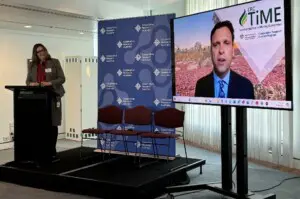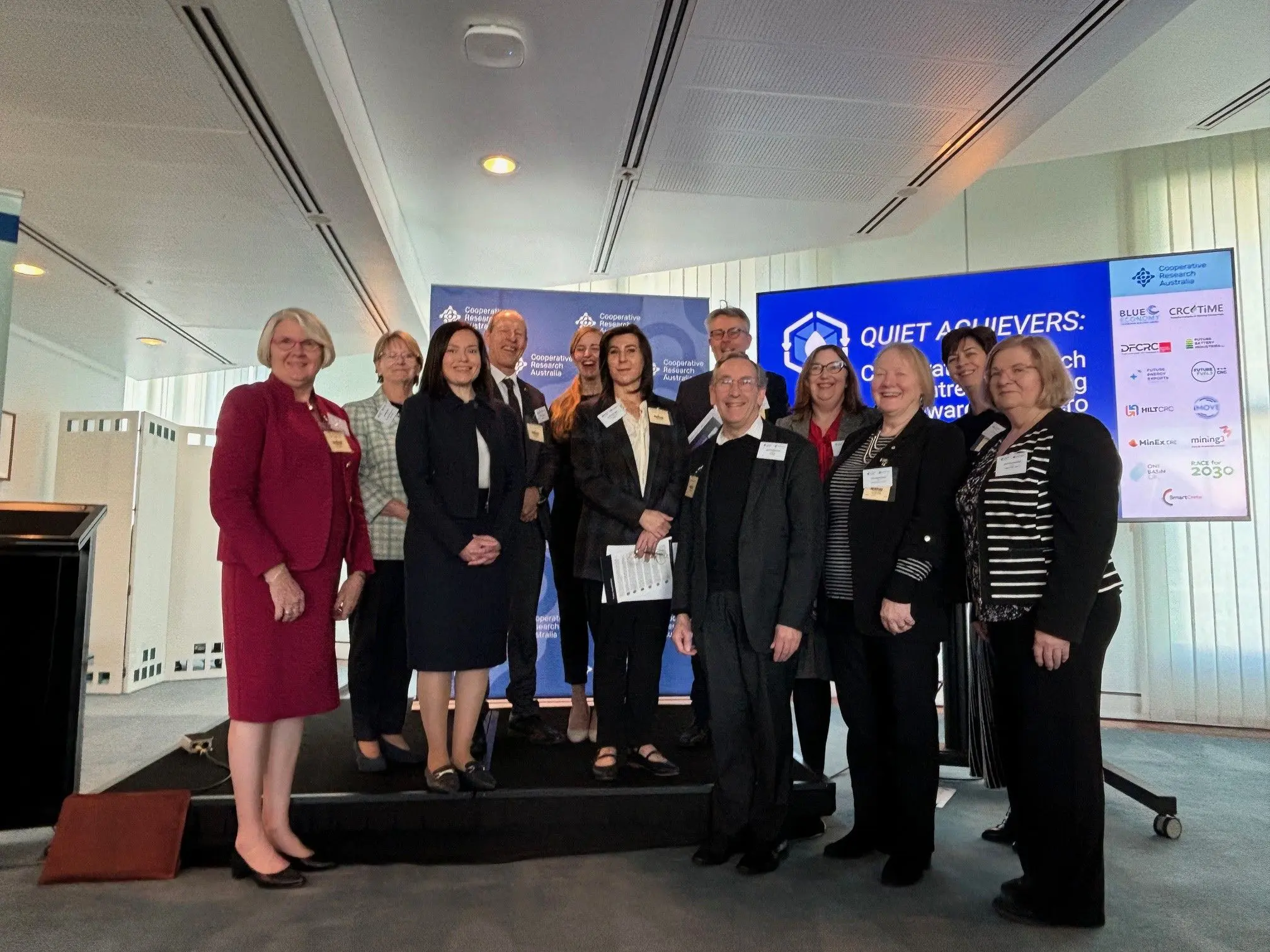Cooperative Research Australia (CRA) today launched an independent study that confirms the venerable Cooperative Research Centres (CRC) Program is generating billions of dollars in C02 abatement outcomes and decarbonisation-focused economic activity, creating thousands of jobs by unlocking substantial private sector R&D.
The report, undertaken by ACIL Allen, showcases the contribution of 13 CRCs/post-CRCs who are directly or indirectly supporting Australia’s decarbonisation goals.
“Australia’s globally renowned CRC Program is at the forefront of efforts to achieve our ambitious climate change targets, with more than $1 billion of private and public investment in research and development to help Australia reach Net Zero by solving gnarly industry
problems.” said Jane O’Dwyer, CEO of CRA.

CRC TiME CEO Dr Guy Boggs giving a pre-recorded address at Parliament House, Canberra
ACIL Allen estimates that this investment, which is only a subset of the full CRC investment, will generate an estimated $4.8 billion in additional economic output for Australia, $3.3 billion in cumulative undiscounted CO2 abated, and thousands of jobs, from 2017-2032.
“These CRCs have extraordinary reach throughout the economy, bring together over 1,600 partners and project participants across research, industry and government, with links into more than 18 countries across Europe, the America, Asia and Oceania.
“The CRC model provides a well-established mechanism for unlocking private-sector R&D investment and fostering productive industry-research collaboration. That co-investment with industry, and collaboration across industry and research, is critical to Australia being able to meet its decarbonisation goals.
“But, there is still significant work to be done if we are to reach these ambitious climate targets. CRCs provide important national capacity that is readily scalable to accelerate change and innovation. With relatively little additional Federal investment and increased flexibility, the CRCs can supercharge our decarbonisation efforts across a huge breadth of sectors from concrete to transport, from heavy industry to future fuels, from the oceans to finance,” Ms O’Dwyer added.
The report, titled Mapping and quantification of CRCs’ work on decarbonisation, forecast that
the contribution of this group of 13 CRCs over 2017-2032 will:
- Generate substantial economic activity: an increase of $4.8 billion in Australia’s
economic output (GDP). - Raise economic welfare across Australia: an increase of $1.7 billion to Australia’s
real economy as a result of industry-led decarbonisation research and innovation. - Create significant employment opportunities: 3,705 job years to 2032 are
delivered (an average of 265 FTE jobs years per year). - Provide significant value for money: $5.80 generated in additional economic
output (GDP) for every dollar of investment and in-kind contributions.
“Decarbonisation is a highly complex global issue with a wide array of policy, market, and social considerations at play,” Ms O’Dwyer said.
“What we can clearly see is that the extent to which CRCs are helping propel Australia towards a sustainable, prosperous, and decarbonised future; one where Australia realises its emissions goals.”
The decarbonisation challenge
A 2023 review by the International Energy Agency into Australia’s energy targets1 highlighted that while recent policies support decarbonisation, significant changes will be needed to reach net zero by 2050.
Under current projections, Australia is expected to reduce its greenhouse gas emissions by 37% below 2005 levels by 2030, well short of our reduction target of 43% from 2005 levels by 2030.
“Achieving a Net Zero economy will require a collective and collaborative effort across all
sectors and sections of society – the CRC model is well placed to facilitate this collective
action,” said ACIL Allen Director of the Science and Technology practice, Dr John
Söderbaum.
“Australia has a suite of decarbonisation-related policies and strategies aimed at supporting Australia’s national decarbonisation goals. The work of the CRCs is strongly aligned with these goals and there is strong potential to further enhance their work programs to expand
the CRC contribution to realising Net Zero outcomes,” Dr Söderbaum added.
CRCs a ready-made solution
Chair of the study’s Steering Committee and initiator of the project, CRC TiME CEO, Dr Guy Boggs, said CRCs represent an important lever to support more rapid progress toward Australia’s decarbonisation goals.
“CRCs provide an effective and flexible mechanism for stakeholders from different sectors to work together, leverage their collective expertise, and address complex challenges through collaboration and strategic investment in delivery, translation and commercialisation of
research,” Dr Boggs said.
“The CRC model is a ready-made solution that is already delivering significant impact. Mobilising this collective capacity is an immense opportunity, with additional and more flexible funding models needed to help further drive this collaboration across CRCs to deliver
even more benefits for the Australian economy as we transition to Net Zero.”
The report highlights several ways that the Commonwealth-funded CRC Program is bringing
together industry, universities and government to apply evidence-based research to help
reach Net Zero.
For example, Blue Economy CRC is harnessing clean energy to fuel offshore commercial vehicles as they operate out at seas; Future Fuels CRC is undertaking world-leading work on supporting adoption of Net Zero emission fuels; iMove CRC is accelerating electrification
in mass transport; and SmartCrete CRC is developing technologies to transform hard-toabate sectors such as concrete and cement.
“This work shows CRCs to be a critical part of the nation’s research and innovation infrastructure. In particular, they are a responsive and integral partner on the path to NetZero, committed to collaborative actions to help deliver on Australia’s decarbonisation mission,” Dr Boggs said.
“The activities of CRCs have evolved over time to meet Australia’s growing decarbonisation needs and industry priorities, demonstrating the flexibility of the CRC model. Working across multiple sectors, there is potential for the CRCs’ individual and collective capability to be
leveraged to contribute even more toward our ambitious climate goals.
“The opportunity is now to develop a shared action plan across government to further harness this infrastructure and draw on the capacity and capability of the CRCs towards Net Zero.”
View the Report, Fact Sheet and Case Studies Booklet on the Cooperative Research Australia website.

